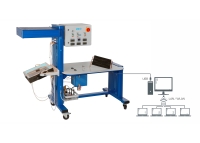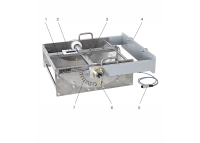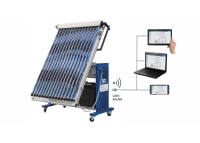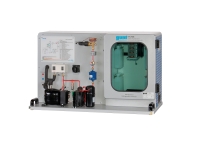Solar energy
Energy galore
The amount of solar energy that falls on the Earth’s land areas over one year is almost 2000 times greater than the entire world’s energy demand. Given the global climate problem, using this potential in the best possible way seems self-evident.
The advantages of converting light into electricity directly are well known: solar power contributes to protecting the environment, reduces the cost of electricity transmission and provides an independent and affordable energy supply.

Determining the characteristic parameters of a photovoltaic system
Learning objectives/experiments
- physical behaviour of photovoltaic modules under a variety of effects
- illuminance
- temperature
- shading
- familiarisation with key parameters
….

Expansion module for ET 250 with components for independent use of electricity from photovoltaic modules
Learning objectives/experiments
- familiarisation with practical components for stand-alone use of photovoltaic electricity
- functioning of a DC switch-disconnector and over voltage protection
- functioning of a charge regulator with integrated maximum power point tracking
- influence of the workload on the efficiency of components
- influence of fluctuations in solar energy and/or electricity usage on the overall system efficiency

Expansion module for ET 250 with components for grid-connected usage of solar electricity
Learning objectives/experiments
- familiarisation with components from grid-connected use of photovoltaic power
- functioning of a DC switch-disconnector and over voltage protection
- functioning of a grid-connected inverter with maximum power point tracking
- dependence of the inverter efficiency on the workload
- function of modern energy meters

Investigation of the properties of solar cells; objective measurements by extensive temperature control of solar cells
Learning objectives/experiments
- physical behaviour of solar cells under varying illuminance and temperature
- recording of current-voltage curves
- calculating current strength and achievable output based on the single diode model
- how illuminance and temperature affect the curves
- interconnecting solar cells in parallel and series connection
….
Solar thermal energy is defined as using solar power to provide heat. The heat can be used for heating in the home and for heating domestic water, as well as for process heat in industry and for steam generation in power stations and even for cooling.

Determining characteristic parameters of a solar thermal system; model fitted with artificial radiation source
Learning objectives/experiments
- design and operation of a simple solar thermal system
- determining the net power
- energy balance on the solar collector
- influence of illuminance, angle of incidence and flow rate
- determining efficiency curves
….

Function and operating behaviour of a parabolic trough collector, accessorie for ET 202
Learning objectives/experiments
- focusing solar radiation with a parabolic trough mirror
- optical concentration factor
- conversion of radiant energy into
heat - losses in thermal solar collectors
….
Function and operating behavior of a parabolic trough collector, astronomical and sensor-based sun tracking, system control via PLC
Learning objectives/experiments
- focusing of solar radiation with a parabolic trough mirror
- optical concentration factor
- DNI: Direct Normal Irradiance
- sensor-based sun tracking
- astronomical sun tracking
….

Demonstration of the conversion of the sun's radiation energy into heat and the storing of that heat, operating the solar controller via web browser
Learning objectives/experiments
- familiarisation with the functions of the flat collector and the solar circuit
- determining the net power
- relationship between flow and net power
- determining the collector efficiency
- relationship between temperature difference (collector/environment) and collector efficiency

Familiarisation with the functions of the evacuated tube collector and the solar circuit, operating the solar controller via web browser
Learning objectives/experiments
- familiarisation with the functions of the evacuated tube collector and the solar circuit
- determining the net power
- relationship between flow and net power
- determining the collector efficiency
- relationship between temperature difference (collector/environment) and collector efficiency

Pivotable flat collector for converting solar energy into heat
Learning objectives/experiments
- layout and function of the flat collector
- determining the net power
- how temperature, illuminance and angle of incidence affect the collector efficiency
- integration of a flat collector in a modern heating system
- hydraulic and control engineering operating conditions
….

Conversion of solar energy into heat in the evacuated tube collector
Learning objectives/experiments
- design and operation of the evacuated tube collector
- determining the net power
- parameters affecting collector efficiency
- integration of an evacuated tube collector in a modern heating system
- hydraulic and control engineering operating conditions
….

Module with buffer storage and bivalent storage for heating systems with renewable energies, operating the heating controller via touch screen or web browser
Learning objectives/experiments
- the following learning objectives can be worked through, depending on the selected HL 320 modular combination:
- familiarisation with modern heating systems based on renewable energy sources
- commissioning of heating systems with solar thermal energy and heat pump
- electrical, hydraulic and control engineering operating conditions
- properties of various heat storage methods
….

Heat transport between heating element and vessel wall by convection and radiation
Learning objectives/experiments
- experiments in vacuum
- heat transfer by radiation
- determination of the radiation coefficient
- experiments at ambient pressure or positive gauge pressure
- heat transfer by convection and radiation
….
- heat transfer by convection and radiation
Solar cooling means a process in which the cooling process is powered directly by solar energy. Solar energy thus serves as a regenerative source of energy.

Determining the characteristic parameters of a photovoltaic system
Learning objectives/experiments
- physical behaviour of photovoltaic modules under a variety of effects
- illuminance
- temperature
- shading
- familiarisation with key parameters
….

Compression refrigeration system for operation with solar current from ET 250
Learning objectives/experiments
- supply a compression refrigeration system with current from photovoltaic modules
- components of a photovoltaic refrigerating plant
- operation of the compressor with changing power available and cooling demand
- charge and discharge cold accumulators
- coefficient of performance of the refrigerating plant dependent on operating conditions
….

Power supply for laboratory experiments with ET 256
Learning objectives/experiments
- in conjunction with ET 256:
- operation of a compression refrigeration system with direct current
- influence of current and voltage on the operating behaviour of the refrigerating plant
- control/regulation of a solar-current refrigeration system with different electrical power supply

Cold production using thermal energy. Transparent condenser and evaporator allow the view into the inner workings.
Learning objectives/experiments
- understanding compression refrigeration systems based on the vapour jet method
- clockwise and anticlockwise Rankine cycle
- energy balances
- calculation of the coefficient of performance of the refrigeration circuit
- thermodynamic cycle in the log p-h diagram
….

Solar thermal operation of a vapour jet compressor
Learning objectives/experiments
- use of solar heat for refrigeration
- components of solar refrigerating plants according to the vapour jet method
- operation of a vapour jet compressor on a solar thermal flat collector
- optimisation of the operating point
- energy balances
….

Demonstration of the conversion of the sun's radiation energy into heat and the storing of that heat, operating the solar controller via web browser
Learning objectives/experiments
- familiarisation with the functions of the flat collector and the solar circuit
- determining the net power
- relationship between flow and net power
- determining the collector efficiency
- relationship between temperature difference (collector/environment) and collector efficiency

Familiarisation with the functions of the evacuated tube collector and the solar circuit, operating the solar controller via web browser
Learning objectives/experiments
- familiarisation with the functions of the evacuated tube collector and the solar circuit
- determining the net power
- relationship between flow and net power
- determining the collector efficiency
- relationship between temperature difference (collector/environment) and collector efficiency








